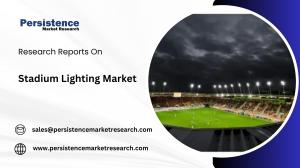Stadium Lighting Market Booms with Shift from Metal Halide to Long-Lasting LED Lights
The stadium lighting market is growing rapidly due to the shift from metal halide lights to energy-efficient LED lights.
BRENTFORD, ENGLAND, UNITED KINGDOM, October 9, 2025 /EINPresswire.com/ -- The global stadium lighting market is witnessing rapid growth due to the transition from traditional metal halide lights to advanced LED solutions. Metal halide lights, which typically last around 6,000 hours, require frequent replacement and involve higher maintenance costs. In contrast, LED lighting systems offer shockproof and water-resistant features with a lifespan of up to 100,000 hours, significantly reducing operational costs and improving efficiency.
Market statistics indicate that the adoption of LED-based stadium lighting is accelerating across sports arenas, concert venues, and multipurpose stadiums. The increasing trend of connected lighting systems, which integrate lighting, controls, and sensors, allows real-time monitoring and remote control via dashboards accessible on mobile devices or computers. North America currently leads the stadium lighting market due to its high adoption of technologically advanced stadiums and strong investments in sporting infrastructure. The LED segment dominates the market, driven by energy efficiency, government regulations, and the growing demand for sustainable lighting solutions.
𝐆𝐞𝐭 𝐚 𝐒𝐚𝐦𝐩𝐥𝐞 𝐏𝐃𝐅 𝐁𝐫𝐨𝐜𝐡𝐮𝐫𝐞 𝐨𝐟 𝐭𝐡𝐞 𝐑𝐞𝐩𝐨𝐫𝐭: https://www.persistencemarketresearch.com/samples/24532
Key Highlights from the Report
LED lighting is replacing traditional metal halide bulbs in stadiums worldwide.
Connected lighting systems enhance fan experience and operational efficiency.
Government regulations promoting energy efficiency drive LED adoption.
North America remains the largest regional market due to advanced sports infrastructure.
Metal halide lights have higher maintenance and operational costs compared to LED.
Increasing sustainability initiatives boost demand for energy-efficient stadium lighting.
Market Segmentation
The stadium lighting market can be segmented based on product type, including LED lights, metal halide lights, and fluorescent lights. Among these, LED lights hold the largest share due to their superior energy efficiency, longer lifespan, and lower maintenance costs. Metal halide lights, while still used in older stadiums, are gradually being phased out because of higher energy consumption and safety concerns. Fluorescent lights find limited applications, mainly in smaller arenas or training grounds, due to lower brightness levels.
End-user segmentation includes sports stadiums, entertainment arenas, multipurpose venues, and training facilities. Sports stadiums remain the leading segment, driven by global sporting events, the popularity of football and cricket, and the increasing emphasis on high-quality spectator experiences. Multipurpose venues are increasingly adopting connected LED systems to host concerts, exhibitions, and corporate events, enabling flexible lighting solutions that improve operational efficiency.
𝐃𝐨 𝐘𝐨𝐮 𝐇𝐚𝐯𝐞 𝐀𝐧𝐲 𝐐𝐮𝐞𝐫𝐲 𝐎𝐫 𝐒𝐩𝐞𝐜𝐢𝐟𝐢𝐜 𝐑𝐞𝐪𝐮𝐢𝐫𝐞𝐦𝐞𝐧𝐭? 𝐑𝐞𝐪𝐮𝐞𝐬𝐭 𝐂𝐮𝐬𝐭𝐨𝐦𝐢𝐳𝐚𝐭𝐢𝐨𝐧 𝐨𝐟 𝐑𝐞𝐩𝐨𝐫𝐭: https://www.persistencemarketresearch.com/request-customization/24532
Regional Insights
North America continues to dominate the stadium lighting market, primarily due to technological advancements, the presence of well-established sports infrastructure, and the early adoption of LED solutions. Connected lighting systems are being widely implemented in U.S. stadiums to enhance fan engagement and energy efficiency.
Europe follows closely, driven by government regulations promoting energy-efficient lighting solutions and investments in modernizing existing sports facilities. Countries like Germany, France, and the U.K. are actively upgrading stadium lighting systems to LED, thereby reducing energy consumption and carbon footprints.
Market Drivers
The primary driver of the stadium lighting market is the shift from metal halide lights to LED solutions. LED lights offer longer lifespan, lower maintenance costs, and superior energy efficiency. Additionally, the integration of connected lighting systems enables dynamic lighting effects, fan engagement, and operational monitoring, further propelling market growth.
Market Restraints
High initial costs of LED systems and replacement of existing metal halide infrastructure can act as barriers. While LEDs save energy in the long term, the upfront investment and installation costs may hinder adoption in smaller or budget-constrained stadiums.
Market Opportunities
The growing focus on sustainable and energy-efficient lighting presents significant opportunities for manufacturers. Additionally, the rising popularity of multipurpose stadiums and increasing adoption of smart, connected lighting solutions can further drive market expansion. Sports events with global viewership and virtual fan engagement are creating demand for innovative lighting technologies.
𝐁𝐮𝐲 𝐍𝐨𝐰 𝐭𝐡𝐞 𝐃𝐞𝐭𝐚𝐢𝐥𝐞𝐝 𝐑𝐞𝐩𝐨𝐫𝐭: https://www.persistencemarketresearch.com/checkout/24532
Reasons to Buy the Report
✔ Comprehensive analysis of stadium lighting market trends and growth drivers.
✔ Detailed segmentation by product type, end-user, and region.
✔ Insights into government regulations and technological advancements.
✔ Competitive landscape and strategies of leading market players.
✔ Forecast of market size and CAGR from 2025 to 2033.
Frequently Asked Questions (FAQs)
How Big is the Stadium Lighting Market?
Who are the Key Players in the Global Stadium Lighting Market?
What is the Projected Growth Rate of the Stadium Lighting Market?
What is the Market Forecast for 2032?
Which Region is Estimated to Dominate the Stadium Lighting Industry through the Forecast Period?
Company Insights
Key players operating in the global stadium lighting market include:
Signify N.V. (Philips Lighting)
Eaton Corporation
Musco Lighting
GE Current, a Daintree Company
AEC Illuminazione S.r.l.
Toshiba Lighting & Technology Corporation
Recent Developments:
Musco Lighting introduced smart LED floodlights with integrated IoT capabilities for remote monitoring in stadiums.
Signify N.V. partnered with major European sports arenas to deploy connected LED lighting systems for enhanced fan engagement and energy efficiency.
Related Reports:
Welding Robotics Market: The global welding robotics market is projected to grow from US$ 10.2 billion in 2025 to US$ 19.9 billion by 2032, at a CAGR of 10% during 2025-2032
Data Center Liquid Cooling Market: The global data center liquid cooling market is set to grow from US$ 4.5 billion in 2025 to US$ 21.8 billion by 2032, at a CAGR of 25.3%
Pooja Gawai
Persistence Market Research
+1 646-878-6329
email us here
Visit us on social media:
LinkedIn
Instagram
YouTube
Legal Disclaimer:
EIN Presswire provides this news content "as is" without warranty of any kind. We do not accept any responsibility or liability for the accuracy, content, images, videos, licenses, completeness, legality, or reliability of the information contained in this article. If you have any complaints or copyright issues related to this article, kindly contact the author above.

